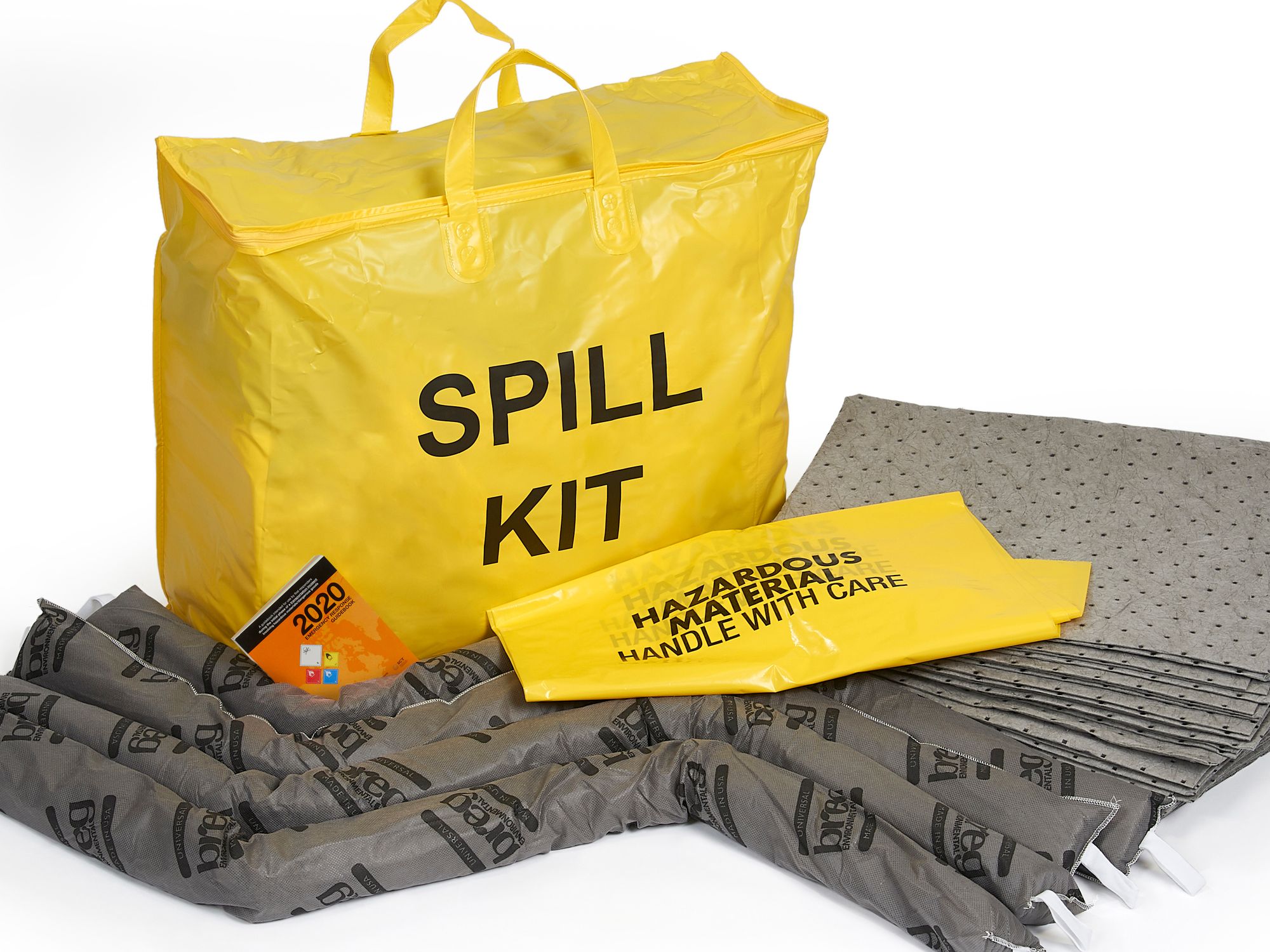Spill response equipment

- Spill kits, carts, or control stations, if well-stocked, located correctly, and used by trained personnel, can lessen the severity of spills and help control a spill incident.
- The type of equipment chosen for the spill kit(s) will depend entirely on the types of substances being used, the processes at the facility, and the types of spills expected.
- Keep supplies and equipment near where spills are most likely to happen and keep them maintained.
Once a spill has begun, the success of the spill-control efforts depends more upon minimizing the volume of what has been spilled than any other control activity.
Spill kits, carts, or control stations, if well-stocked, located correctly, and used by trained personnel, can lessen the severity of spills and help control a spill incident.
In any spill situation, equipment may be necessary to:
- Rescue and treat victims;
- Protect response personnel;
- Mitigate hazardous spill conditions; and/or
- Clean up the spill.
Selecting equipment
When selecting the type and quantity of equipment, consider the following:
- The types of spills that could arise. Know what the probable and worst-case scenarios are at the facility;
- The types of hazards that employees may be exposed to and the appropriate containment, mitigative, and protective measures;
- The capabilities and estimated response times of offsite responders;
- The number of site employees who could be victims during the spill incident; and The probable number of trained personnel available for response.
Spill kits
The type of equipment chosen for the spill kit(s) will depend entirely on the types of substances being used, the processes at the facility, and the types of spills expected. Optionally, a facility may purchase pre-stocked kits, or assemble an assortment of clean-up items. Materials can be bought that are specifically designed to absorb or neutralize in-plant chemicals. Some factors to keep in mind include:
- Disposal costs: Some items are more expensive to purchase up front, but are much easier and cheaper to dispose of once they are used. For instance, some oil absorbents are inexpensive to buy, but are very expensive to dispose of. When incinerated, approximately 98 percent of the original substance is left and the ash must them be disposed of. On the other hand, corn cobs are a little more expensive to purchase, but approximately 98 percent will burn, so that only leaves two percent of ash to dispose of.
- Absorption rates: Some substances absorb more per surface area than others. More absorbent pillows, for instance, mean less of them can be used, reducing the total cost.
- Absorption times: The time for absorption to occur varies. In general, there is a higher cost for speed. In many cases, it doesn’t matter if the spill is absorbed in seven minutes, or 70 minutes. But if the spilled material is flowing down a drain — every second matters!
- Safety factors: Always keep safety in mind when stocking the kit.
Test the materials selected. Use the absorbents stocked on the chemicals in-house to see what kinds of reactions occur, how long absorption takes, and how easy or difficult it is to dispose of the clean-up materials. Make sure designated responders are in on the drills.
Typical items found in spill kits, carts, and control stations include:
- Patch and plug kits to stop leaks;
- Loose sorbent materials such as sawdust, vermiculite, or kitty litter ready to sprinkle on a spill;
- Materials such as clay, vermiculite, or diatomaceous earth, packaged in pillows and socks designed to absorb and/or adsorb liquids;
- Absorbent toweling, pads, and/or mats;
- Storm drain covers or spill mats used to block or prevent the flow of spills;
- Booms for spills that float on water or sorbent-filled booms used for land-based spills;
- Temporary dikes, berms, curbing, or other barriers;
- Brooms, mops, shovels, scoops, scrapers, squeegees, flashlights, hammers, wrenches, or other non-sparking hand tools;
- Acids and bases neutralizers;
- Environmental monitoring equipment;
- Salvage bags, buckets, and/or drums to contain or collect spill material and waste;
- Signs, tags, labels, barricade tape, and markers or other writing equipment;
- Two-way radio, cell phone, contact phone numbers, and/or other communication equipment;
- Medical and first-aid supplies;
- Fire-fighting equipment; and
- Coveralls, gloves, goggles, face-shields, boots, boot covers, respirators, masks, and other personal protective clothing.
Spill kit location
Keep supplies and equipment near where spills are most likely to happen and keep them maintained. Kits should be readily available to be used immediately after a spill happens and before it can spread. For example, portable tanks can be equipped with an unlocked spill kit to be used in the event of a discharge during transfers.
A spill station can be kept in every work area, or a portable spill cart can be present that can be deployed quickly in a spill situation.
Optionally, post a checklist on the spill kit to show when items have been used, or to indicate when the kit was last inspected.
